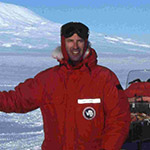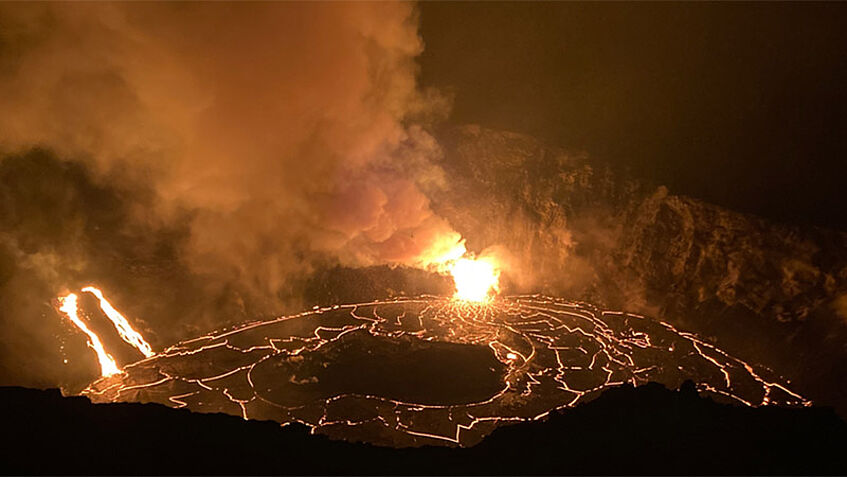From Early Earth to Exoplanets: Is there life?
From Early Earth to Exoplanets: Is there life?
08.06.2021
By looking outward towards planets we can look backwards and understand the history of our planet, explains Eric Gaidos, Ida Pfeiffer professor at the Faculty of Earth Sciences, Geography and Astronomy in this interview. In his research, the astronomer, planetary scientist and geobiologist concentrates on the habitability of exoplanets - an area where we see major avances, although we "are still not sure how to correctly ask the question" and "don't yet have the means to answer it". Nevertheless he thinks, that "this generation, or perhaps the next, might have the first real chance at answering the question that the ancients posed: is there life elsewhere?"

Eric Gaidos joined the Faculty in March 2021 as Ida Pfeiffer Professor. Photo: private
- You are astronomer, planetary scientist and geobiologist - a wide range of highly interesting topics. What fascinates you about this combination or intersection of research fields?
That by looking outward towards planets around other stars we can look backward and better understand the history of our planet. And that we now study the formation of worlds both with telescopes – to look at the youngest stars – and with microscopes – to look at the oldest rocks like meteorites. And that this generation, or perhaps the next, might have the first real chance at answering the question that the ancients posed: is there life elsewhere?
- One of your focal points is the formation, detection and characterization of habitable planets. What are recent developments in this field?
Most researchers in this field would agree that the most significant development since the first discovery of planets around other stars (exoplanets) over 25 years ago was the Kepler mission. Kepler revealed that Earth-size planets are relatively common, something we could only speculate about up to that point. Some of these planets are at a distance from their host star that the energy they receive is comparable to Earth, and they might be habitable, but with Kepler alone it is not possible to say much more.
The Kepler mission ended almost three years ago, and one of the most exciting developments today is that the launch of the James Webb Space Telescope, decades in the making, is mere months away. JWST will be the most sensitive instrument ever used to study planets around other stars; it is the largest telescope ever launched, and it senses light at the infrared wavelength where planets are the brightest, but – not coincidentally – where they are very difficult to observe from the ground. JWST will allow us to routinely detect the atmospheres of planets whereas before this was something we could do only for the largest planets (the size of Jupiter), only in some cases, and even those were at the limit. JWST won’t necessarily be able to detect Earth-size, habitable planets but we should be able to study somewhat larger and warmer planets and these data will test the models that predict what Earth-like planets will be like.
"Nachts auf der Sternwarte": On Friday, 11 June, 18:30, Eric Gaidos gave an online lecture on the topic "Lava Worlds - From Early Earth to Exoplanets" (stream online on Youtube)
"Nachts auf der Sternwarte" in June 2021: Eric Gaidos on "Lava Worlds"
- What are the difficulties in answering the question of habitability of planets?
At least two things: first, we are not sure how to correctly ask that question, in other words, what makes a planet habitable? And second, we don’t yet have the means to answer that question even if we knew how to ask it: even the nearest known exoplanets are so far away, and are so faint compared to their star, that a present we can say little more than the size and mass of the planet, and, in some cases, whether it has an atmosphere.
JWST will allow us to detect some of the gases in these atmospheres, but the things that make Earth Earth-like and habitable – water oceans, continents, volcanoes, and plate tectonics – remain well beyond our ability to detect around the nearest stars.
- Why is this topic of great importance in relation to Earth itself?
A few decades ago, our understanding of Earth’s history and climate benefited immensely from the data returned by spacecraft sent to Venus and Mars. In the same way, I expect that the comparative study of Earth-like (and very un-Earth-like) planets around other stars will eventually clarify how our planet formed and came to be the way it is, and not some other way. Alexander von Humboldt would not have been able to construct his global biogeography, nor Charles Darwin have his epiphany of natural selection had these persons stayed put. To understand our home, we must travel. I think Ida Pfeiffer would have agreed.
To understand our home, we must travel. I think Ida Pfeiffer would have agreed.
- You are also teaching a course on Biosignatures and the "Vienna Scale" in the summer semester. Which central message should your students remember?
That the detection of life on other planets will be just as hard to verify as it will be technically challenging, even with the wondrous capability of instruments like JWST. Two scientists that I had the great fortune to meet said „extraordinary claims demand extraordinary evidence“ (Carl Sagan) and „the easiest person to fool is yourself“ (Richard Feynmann). I hope the students recall these principles when amongst the claims that surely lie in the future before us.
The Ida Pfeiffer Professorship of the Faculty of Earth Sciences, Geography and Astronomy supports our mission to conduct excellent research on the sustainability of Planet Earth. Since 2018, the Faculty has been inviting scientists for one semester to trigger exciting research as well as teaching and act as a catalyst in the wide range of research topics addressed at the Faculty.
Image: Ida Pfeiffer, Lithography by Adolf Dauthage
Thank you & welcome to our Faculty!
Lecture of Eric Gaidos at the Center for Astrophysics Harvard & Smithsonian

Photo: University of Hawai'i at Manoa
Eric Gaidos is an astronomer, planetary scientist, and geobiologist and professor at the Department of Earth Science at the University of Hawai`i at Manoa. His research is on the formation, evolution, detection, and characterization of habitable planets around stars, and the potential distribution of life (astrobiology).
Working group / host professor at our Faculty: Manuel Güdel
Courses in the summer term 2021: Biosignatures and the "Vienna Scale"
Publication list
- Recommend publications:
- Chao, K.H., deGraffenried, R., Lach, M., Nelson, W., Truax, K., and Gaidos, E. (2021) Lava Worlds, form Early Earth to Exoplanets, Geochemistry.
- Gaidos, E, Mann, A.W., Kraus, A.L. and Ireland, M. (2016) They are small worlds after all: revised properties of Kepler M dwarf stars and their planets. Monthly Notices of the Royal Astronomical Society.
- Gaidos, E., Marteinsson, V. et al (2008) An oligarchic microbial assemblage in the anoxic bottom waters of a volcanic subglacial lake. Nature ISME Journal.


